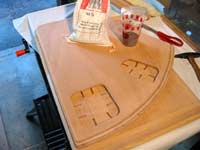Lead Shot Centerboard Ballast
by David Farless
The plans for Cartopper (a Phil Bolger design for Dynamite Payson) call for 3.3 lb of lead ballast in the centerboard. This keeps the plywood centerboard from floating up into the centerboard trunk. The plans show a square hole 4” on a side, to be filled with molten lead. Since the centerboard is made of 1/2” thick plywood, the volume of this hole is .8 in3, just right to hold 3.3 lb of lead with a density of 6.57 oz/in3.
I decided to use lead shot buried in epoxy for the ballast. I wanted to avoid the risks of pouring molten lead (spilling it on my person, getting splattered by dropping something wet into the cauldron, breathing nasty fumes, etc). Also, I have some experience with the use of lead shot as ballast on radio controlled model sailboats.
The first problem turned out to be getting the lead shot. It is available over the internet and at some (but not all) gun shops and shooting ranges. But, it usually only comes in 25-lb bags and is not cheap. I finally remembered that my radio controlled sailboat kit came with lead shot for use in the keel, so I called Victor Model Products and they agreed to send me 4 lb of #9 lead shot for $1.00 per pound.
These #9 lead spheres are small, about 0.08” O.D. But they still do not pack as tightly as molten lead, so I would need more volume to contain the specified 3.3 lb. The folks at Victor Model Products said to add about 30% to the volume required for solid lead to get an equivalent weight of lead shot. So, in place of the 4” x 4” hole specified in the plans, I cut a hole 4.5” x 5”. (See larger of two holes in the photo below.)
Centerboard with holes ready to receive lead shot. The holes have been lined with brass ring nails to secure the epoxy-lead mass to the centerboard.
(click images for larger views)
|
 |
|
The hole, once it was actually cut out, was a bit of an odd shape, with rounded corners to prevent any stress points. I calculated the area of the hole to be about 19.7 in2. My centerboard is laminated from two pieces of 6-mm plywood, so the hole is only 12 mm (0.4724”) deep. This makes the volume of my odd hole about 9.3 in3. This is an increase of only 16% over the specified 4” x 4” x 0.5” hole. But based on the Victor factor of 30% extra volume required, this volume should hold almost 3 lb… close enough for me.
I then conducted a dry test, filling the hole with lead shot. It only held a little over 2 lb (33 oz). This was significantly less that I expected. Something was wrong!
I could think of only two possibilities. One is that these lead shot might not be pure lead, but might contain, or be coated with, lighter materials. The other is that the factor of 30% does not apply well for shallow holes like mine; i.e., holes which have a relatively high ratio of surface area to volume. It is evident that spheres pack more densely with each other than they do against a flat wall.
To check the real density of the lead shot, I ran a test using the ancient Archimedes water displacement principal. I filled a plastic baby bottle half full of water. (The baby bottle was the only thing I could find with level markings at relatively fine intervals.) I then weighed out 448 gram of shot (about 1 lb, but my scale is more accurate in grams than in ounces) and poured it into the bottle. The level of the water in the bottle increased by about 2.5 oz. (This is a volumetric ounce which converts to about 1.8 in3.) Doing the math, the density of the lead shot material is 6.56 oz/ in3, so it looks like these shot are essentially pure lead. Good!
Anyway, it was evident that I needed more lead shot in the CB than I could get in the hole I had already cut. So, I cut another hole, well away from the first hole. I reasoned that this should work well, since the weight in the second hole would come into play as the CB reached the bottom of its travel where the weight in the first hole is no longer as effective. Since the first hole accepted 2 lb of lead shot, I needed another hole with an area a little more than half the area of the first hole to get another 1.3 lb of lead shot aboard. I roughed out a second hole that has an area of about 11 sq in. This hole actually accepted only about 1 lb. Once again, less than expected. I could have gotten more lead shot into this hole (and probably into the first hole) but I wanted to stop soon enough to keep any shot from protruding above the top of the hole. After avoiding the hazards of molten lead I did not want to create a new hazard by sanding down the tops of lead shot protruding above the level of the centerboard surface and releasing lead dust into the air!
So, I ended up with a little over 3 lb of lead in the centerboard, surrounded by an ounce or so of epoxy. The total volume is about 14.5 in3 or twice the volume required for solid lead!
|
Here is the centerboard with the lead shot epoxied in place. (The centerboard has since been encased in fiberglass.) |
|

